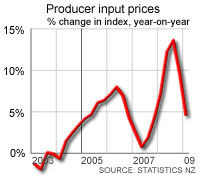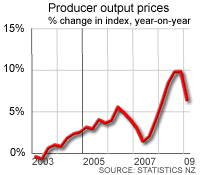 Producer price inflation fell in the September quarter for both input and outputs from record levels in the June quarter, thanks largely to a 31.4% fall in the spot power price because of the end of the drought. But overall producer price inflation was higher than economists expected, which may temper expectations of big falls in interest rates.
The result is one note of caution for the Reserve Bank to consider as it plans its likely cut in the Official Cash Rate on December 4, with all four big bank economists currently expecting a 100 basis point cut to 5.5% as inflation pressures ease and the recession looks to be longer and deeper than previously expected.
Input prices rose 3.7% in the September quarter from the June quarter, which was down from the 5.6% seen in the June quarter, but was above the 3% median economist expectation. Output prices rose 2.8% in the quarter, which was down from the 3.5% seen in the June quarter, but was above the 2% median economist expectation.
Producer price inflation fell in the September quarter for both input and outputs from record levels in the June quarter, thanks largely to a 31.4% fall in the spot power price because of the end of the drought. But overall producer price inflation was higher than economists expected, which may temper expectations of big falls in interest rates.
The result is one note of caution for the Reserve Bank to consider as it plans its likely cut in the Official Cash Rate on December 4, with all four big bank economists currently expecting a 100 basis point cut to 5.5% as inflation pressures ease and the recession looks to be longer and deeper than previously expected.
Input prices rose 3.7% in the September quarter from the June quarter, which was down from the 5.6% seen in the June quarter, but was above the 3% median economist expectation. Output prices rose 2.8% in the quarter, which was down from the 3.5% seen in the June quarter, but was above the 2% median economist expectation.
 Input price inflation in the September quarter from the same quarter a year ago was 13.6%, which was the largest annual move since September 1987 and up from 11.8% in the June quarter. Output price inflation from a year ago was 9.8%, the largest since March 1987 and above the 8.5% seen in the June quarter.
What it might mean
These inflation figures have yet to register the impact of a sharp dive in commodity prices and fuel prices in September and October as global recession loomed, which may soften the impact of the worse than expected result on the Reserve Bank's thinking.
The outlook for the OCR remains for a drop from 6.5% currently to 4-4.5% in the next 6 months. This makes shorter term 6 month and 1 year fixed mortgage rates of around 8% more attractive given a likely drop in variable mortgage rates to 7% or so over the next year. See all published mortgage rates here.
However, the likely drop in the OCR makes longer term deposit rates of 18 months to 2 years of 6 to 7% more attractive for savers who want to lock in higher rates for longer. Short term deposit rates could easily be 5% or lower by the middle of next year. See all term deposit and debenture rates of 12 months or longer here and all term deposit rates of up to 12 months here.
Input price inflation in the September quarter from the same quarter a year ago was 13.6%, which was the largest annual move since September 1987 and up from 11.8% in the June quarter. Output price inflation from a year ago was 9.8%, the largest since March 1987 and above the 8.5% seen in the June quarter.
What it might mean
These inflation figures have yet to register the impact of a sharp dive in commodity prices and fuel prices in September and October as global recession loomed, which may soften the impact of the worse than expected result on the Reserve Bank's thinking.
The outlook for the OCR remains for a drop from 6.5% currently to 4-4.5% in the next 6 months. This makes shorter term 6 month and 1 year fixed mortgage rates of around 8% more attractive given a likely drop in variable mortgage rates to 7% or so over the next year. See all published mortgage rates here.
However, the likely drop in the OCR makes longer term deposit rates of 18 months to 2 years of 6 to 7% more attractive for savers who want to lock in higher rates for longer. Short term deposit rates could easily be 5% or lower by the middle of next year. See all term deposit and debenture rates of 12 months or longer here and all term deposit rates of up to 12 months here.
Producer price inflation rate down, but more than expected
Producer price inflation rate down, but more than expected
19th Nov 08, 11:45am
by

We welcome your comments below. If you are not already registered, please register to comment.
Remember we welcome robust, respectful and insightful debate. We don't welcome abusive or defamatory comments and will de-register those repeatedly making such comments. Our current comment policy is here.